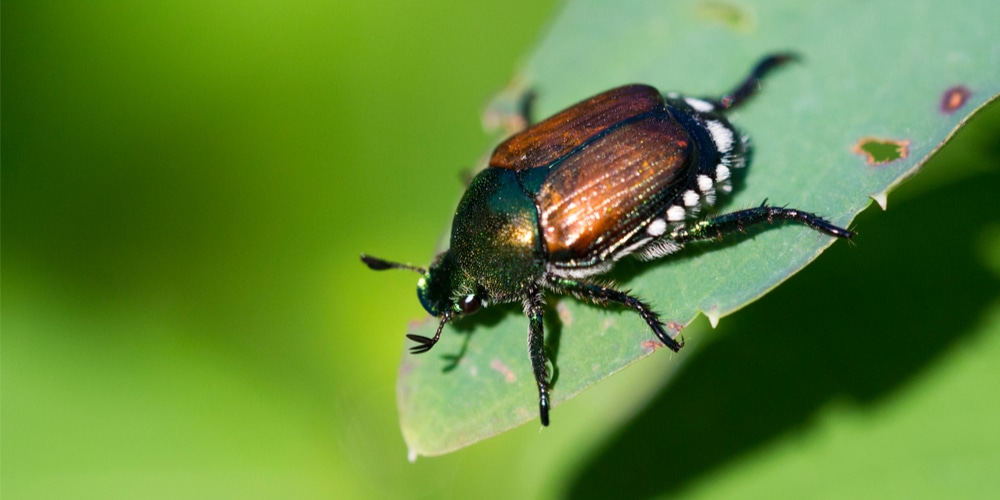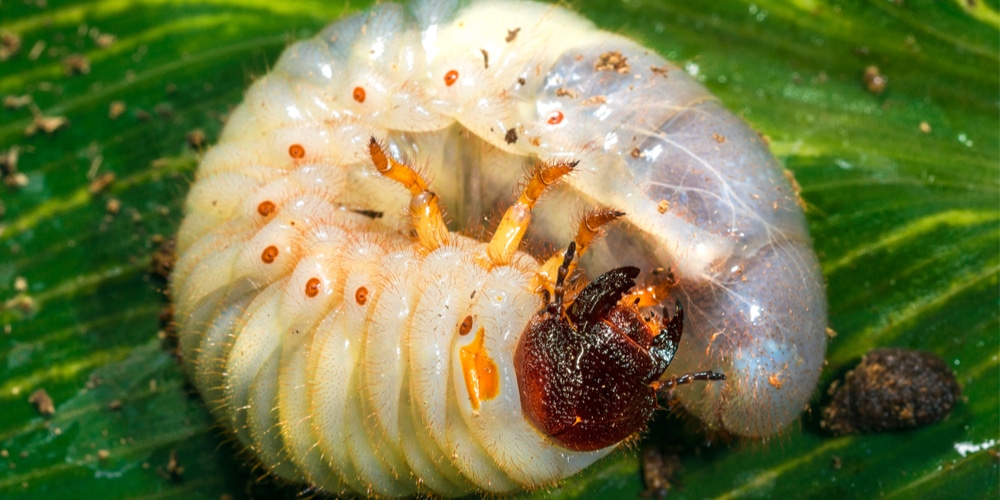Getting Rid of Japanese Beetles in 9 Easy Steps

Step 1: Identify the Pest
- Question: Have you confirmed the presence of Japanese beetles?
- Yes: Proceed to Step 2.
- No: Ensure correct identification before taking action, as treatments may differ for other pests.
Step 2: Physical Removal
- Action: Handpick beetles if the infestation is manageable.
- Method: Early in the morning, when beetles are less active, shake them off plants into a bucket of soapy water to drown them.
Step 3: Use Row Covers
- Question: Are beetles targeting specific, valuable plants?
- Yes: Protect these plants with row covers during the peak feeding period (typically six to eight weeks in early to mid-summer).
- No: Consider broader control methods if the infestation is widespread.
Step 4: Attract Natural Predators
- Action: Encourage or introduce natural predators.
- Options:
- Birds: Install bird feeders or baths to attract birds that eat beetles.
- Beneficial Insects: Promote or introduce predatory insects like ladybugs and lacewings, which feed on beetle larvae.
- Options:
Step 5: Apply Neem Oil
- Action: Use neem oil as an organic treatment.
- Application: Spray neem oil on affected plants, which acts as a repellent and can also disrupt the beetle’s life cycle.
Step 6: Set Beetle Traps
- Question: Do you want to use traps?
- Yes: Place pheromone or floral-scented traps downwind of your garden to lure beetles away.
- Caution: Traps can attract more beetles than they catch if placed improperly, so keep them at least 30 feet away from the plants you want to protect.
- No: If you’re concerned about potentially attracting more beetles, skip to the next step.
Step 7: Use Insecticides
- Question: Is the infestation severe?
- Yes: Consider using insecticides.
- Types: Carbaryl, permethrin, or pyrethrin are effective but should be used as a last resort due to potential impact on beneficial insects and the environment.
- Timing: Apply early in the morning or late in the evening to minimize impact on pollinators.
- No: Continue with less invasive measures.
- Yes: Consider using insecticides.
Step 8: Prevent Future Infestations
- Action: Implement strategies to reduce future beetle populations.
- Soil Treatment: Consider applying milky spore to the soil to target larvae stages of Japanese beetles.
- Lawn Care: Maintain a healthy lawn to discourage female beetles from laying eggs.
Step 9: Monitor and Adjust
- Routine Actions:
- Inspect: Regularly check for beetle activity and the effectiveness of implemented strategies.
- Adapt: Adjust control methods as needed based on ongoing monitoring and results.
Additional Tips
- Plant Selection: Consider planting species that are less attractive to Japanese beetles.
- Cultural Practices: Keep plants healthy and well-watered, as stressed plants are more susceptible to damage.
Identifying Japanese Beetles
Before you take on Japanese beetles, it’s crucial to know what you’re up against.
Recognizing these invaders by their appearance and the unique signs they leave behind is the first step to a beetle-free garden.
Appearance and Lifecycle
Japanese beetles are quite the sharp dressers of the insect world, with their shiny, metallic green bodies and copper-colored wings. Here’s a brief profile to help you spot these critters:
- Size: About 3/8-inch long
- Features: White tufts of hair along their sides
They start off as grubs underground before emerging to wreak havoc.
This transformation from turf-damaging larvae to leaf-loving adults typically happens as follows:
- Grubs hatch from eggs laid in the soil during the summer.
- Feast mode: They feed on roots until the fall.
- Winter nap: They burrow deeper into the soil to overwinter.
- Spring revival: As the ground warms, they resurface.
- June and July bloom: Adult beetles emerge to begin their feeding frenzy.
Signs of Infestation
When Japanese beetles are in town, they don’t exactly keep a low profile. Here’s how to tell if they’re crashing your garden party:
- Skeletonized leaves and flowers: They devour everything but the veins.
- Patchy, browning grass: A tell-tale sign of grubs beneath the surface.
- Groups of beetles: They aren’t the solitary type; you’ll find them partying in clusters.
Preventive Strategies

To shield your garden from the metallic marauders that are Japanese beetles, a proactive approach is your best defense. Here’s how to fortify your greenery against these hungry pests before they strike.
Garden Hygiene
- Remove the Culprits: Regularly inspect your plants. If you spot Japanese beetles, pluck them off before they can lay more eggs or cause further damage.
- Clean-Up: Post-season, clean your garden to remove debris and dead leaves that can harbor beetle eggs and larvae.
Plant Selection
- Choose Wisely: Some plants are like a siren song for Japanese beetles. Avoid favorites like roses and grapevines, and instead opt for beetle-resistant varieties.
- Repellent Plants: Integrate plants that repel Japanese beetles, such as garlic and chives, into your garden.
Natural Predators
- Birds: Attract beetle-eating birds by installing birdhouses and birdbaths.
- Beneficial Insects: Welcome the beetle’s foes like ladybugs and ground beetles, by avoiding pesticides that could harm these allies.
Direct Control Methods
Ready to take on those pesky Japanese beetles? Here’s how you can show them who’s boss in your garden.
Hand Picking
- Early Morning Routine: Slide out of bed and get your coffee; Japanese beetles are less active in the morning, making it the perfect time for you to hand pick them off your plants. Simply pluck them and drop them into a bucket of soapy water to bid them farewell.
Organic Pesticides
- Neem Oil Solution: Spray and slay! Whip up a beetle doom-spray by mixing neem oil with water and a dash of soap. This organic pesticide not only knocks out beetles but also deters them from coming back for seconds.
Chemical Treatments
- Insecticide Power: For a stronger punch, chemical treatments can save your greens from the beetle brigade. Use products like carbaryl or cyfluthrin, but remember to keep it eco-friendly by following the instructions to the letter for effective beetle control.
Environmental Solutions
Japanese beetles might be having a party in your garden, but it’s time to send them packing without harming the planet. You’re gearing up to adopt some environmentally friendly tactics that are all about working with nature, not against it.
Trap Crops
- Plant Decoys: Before these metallic marauders chew through your prized roses, distract them with delicious trap crops.
- You can plant sacrificial plants that Japanese beetles can’t resist, like zinnias or marigolds, away from the plants you want to protect.
- Strategic Placement: Position these appetizing bait plants around the perimeter of your garden.
- The beetles will gorge on these and (fingers crossed) overlook your veggies and flowers.
Beneficial Nematodes
- Tactical Application: Apply these microscopic roundworms to your soil—they’re relentless against Japanese beetle larvae.
- For best results, apply nematodes in late summer or early fall.
- Keep ‘Em Wet: Nematodes need moist soil to wriggle their way to those pesky grubs.
- So grab that watering can and give them a helping hand!
Diatomaceous Earth
- Apply Wisely: This natural, abrasive powder can be a beetle-busting addition to your garden defenses.
- Just remember, it can affect friendlies like bees and ladybugs, so use it as a spot treatment on the soil around affected plants.
- Reapply Post-Rain: Diatomaceous earth loses its mojo when wet, so after a rainstorm, you’ll want to sprinkle on a fresh layer to maintain your beetle barrier.
Long-Term Management
To keep Japanese beetles at bay, consistency is your ally.
Long-term management involves improving soil health, maintaining your lawn, and rallying community efforts to suppress beetle populations for years to come.
Let’s roll up those sleeves and get your garden’s defense ready!
Soil Health
Your soil is the stage for plant growth and beetle battles.
- Introduce beneficial nematodes: These microscopic worms prey on Japanese beetle grubs.
- Apply them to your garden soil during late summer or early fall.
- Use milky spore: This naturally occurring bacterium targets and eliminates grubs over time.
- Patience is key, as it takes a couple of seasons to establish fully.
Lawn Care
Healthy grass gives invaders like the Japanese beetle a tough time establishing a foothold.
- Keep your lawn well-aerated: This practice discourages female beetles from laying eggs in the soil.
- Maintain proper moisture: Watering deeply but infrequently strengthens grassroots and makes it harder for grubs to cause damage.
Community Efforts
There’s strength in numbers when combating Japanese beetles.
- Coordinate beetle treatments: Work with neighbors to treat lawns and gardens at the same time to prevent beetles from simply hoping next door.
- Share successful methods: A beetle-free garden is a team effort, so share what’s working for you and learn from others.
Frequently Asked Questions
Tackling Japanese beetle problems can feel like a battle—but with the right techniques, you can win the war against these pesky garden invaders.
Here’s how to keep your greenery safe with some FAQs on managing, trapping, and repelling Japanese beetles.
What natural remedies can I apply to eliminate Japanese beetles?
- Handpicking: Early in the morning, shake beetles off your plants and into a bucket of soapy water to drown them.
- Neem Oil: Apply neem oil to affected plants, which acts as a natural repellent and disrupts the beetles’ life cycle.
- Beneficial Nematodes: Introduce these microscopic organisms into your soil to target and kill the larvae of Japanese beetles.
What’s the best way to manage a Japanese beetle infestation indoors?
For an indoor infestation, vacuuming up the beetles is effective.
Immediately dispose of the vacuum bag outside to prevent them from escaping back into your home.
Are there effective strategies to eradicate Japanese beetles for good?
Permanent eradication is challenging, but these strategies can greatly reduce beetle populations:
- Milky Spore: Apply this natural bacterium to your lawn to kill the grubs over several seasons.
- Lawn Maintenance: Keep your lawn healthy and well-watered to deter female beetles from laying eggs.
What are the most effective traps for capturing Japanese beetles?
Japanese beetle traps that use pheromones to attract the beetles can be effective; however, place them away from the areas you’re trying to protect to avoid attracting more beetles to your plants.
How can roses be protected from Japanese beetle attacks?
To protect your roses:
- Cover them with fine netting during the peak beetle season to physically block access.
- Use kaolin clay sprays on the rose bushes, which create a protective barrier deterring beetles.
Which homemade sprays work best against Japanese beetles?
Homemade sprays made from mixing a few drops of dish soap into water can dehydrate and kill the beetles when sprayed directly onto them.
Some gardeners also use a garlic and water mixture to repel the beetles from their plants.
Last update on 2025-04-25 / Affiliate links / Images from Amazon Product Advertising API
